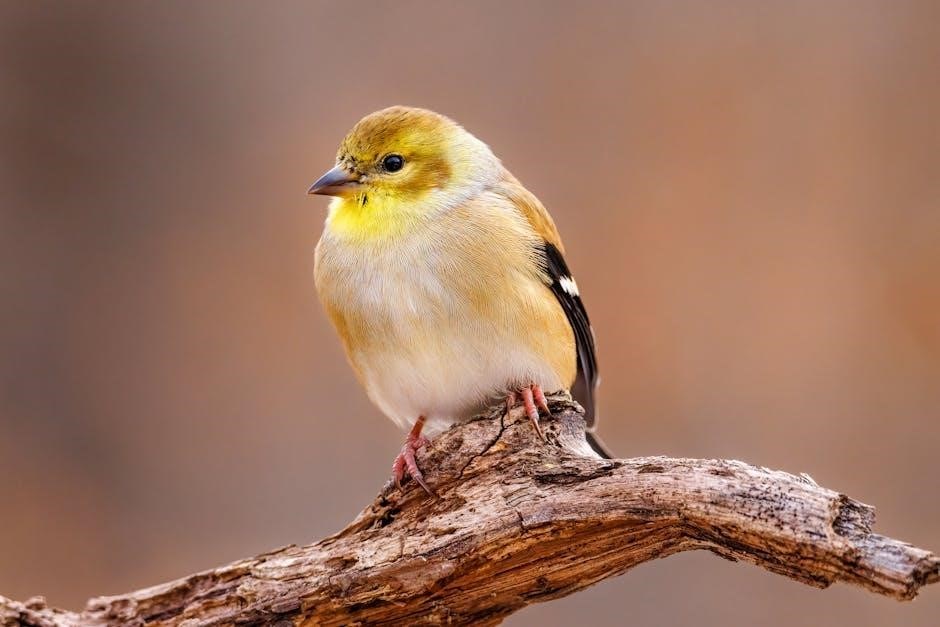Frank Chapman Western Bird Guide provides comprehensive information about western US bird species, including depictions and descriptions, making it a valuable resource for bird enthusiasts and researchers alike naturally․
Overview of the Guide
The guide is a valuable resource for bird enthusiasts, providing a comprehensive overview of the bird species found in the western United States․ The guide includes detailed information about each species, including their habitats, behaviors, and characteristics․ The guide is written in a clear and concise manner, making it accessible to readers of all levels of expertise․ The guide is organized in a logical and easy-to-follow manner, allowing readers to quickly find the information they need․ The guide is a testament to Frank Chapman’s expertise and knowledge of ornithology, and his passion for sharing that knowledge with others․ The guide has become a classic in the field of ornithology, and continues to be widely used and respected today․ The guide’s popularity is a reflection of its usefulness and accuracy, and its ability to inspire and educate readers about the fascinating world of birds․

Background of Frank Chapman
Frank Chapman was an American ornithologist and writer born in New Jersey naturally everyday․
Early Life and Career
Frank Chapman was born on June 12, 1864, in West Englewood, New Jersey, and developed an interest in natural history at a young age․ He attended Englewood Academy and later joined the American Museum of Natural History in 1888 as an assistant to Joel Asaph Allen․ Chapman’s early career involved working with the museum, where he gained valuable experience and knowledge about birds and mammals․ He was eventually made associate Curator of Mammals and Birds in 1901, a position that allowed him to pursue his passion for ornithology․ Chapman’s work at the museum laid the foundation for his future contributions to the field of bird study, including the creation of his Western Bird Guide․ His early life and career played a significant role in shaping his expertise and interests․ He became a renowned ornithologist and writer․

Significance of the Western Bird Guide
Frank Chapman’s guide revolutionized bird identification with detailed descriptions and illustrations naturally every day․
Impact on Bird Identification
The Western Bird Guide has had a profound impact on bird identification, making it easier for enthusiasts to recognize and classify species․ With its detailed descriptions and illustrations, the! guide has become an essential tool for birders․ The guide’s influence can be seen in the way it has shaped the field of ornithology, providing a foundation for future research and study․ By providing a comprehensive and accessible guide, Frank Chapman has enabled people to develop a deeper understanding and appreciation of birds․ The guide’s impact extends beyond the scientific community, inspiring a new generation of birders and naturalists․ Overall, the Western Bird Guide has played a significant role in promoting the study and appreciation of birds, and its influence continues to be felt today․ The guide remains a valuable resource for anyone interested in birds and their habitats․
Contents of the Guide
The guide contains detailed information and illustrations of western bird species naturally every day․
Depictions and Descriptions
The Frank Chapman Western Bird Guide features detailed depictions and descriptions of various bird species, allowing readers to accurately identify and learn about the birds they encounter․
The guide includes short, straightforward portrayals, focusing on key features like tone and size, making it easier for readers to distinguish between different species․
The depictions are accompanied by descriptions that provide additional information about the birds’ habits, habitats, and characteristics․
The combination of depictions and descriptions makes the guide a valuable resource for both novice and experienced birdwatchers․
The guide’s attention to detail and commitment to accuracy have made it a trusted and reliable source for bird enthusiasts․
The depictions and descriptions are carefully crafted to help readers develop a deeper understanding and appreciation of the birds and their natural environments․
The guide’s use of clear and concise language makes it accessible to readers of all ages and backgrounds․

Comparison with Other Guides
Frank Chapman’s guide compares favorably with other notable works like Alexander Wilson and John James Audubon’s publications naturally every day․
Relation to Other Works by Chapman
Frank Chapman’s Western Bird Guide is closely related to his other notable works, including Handbook of Birds of Eastern North America․ This guide is a western counterpart, providing similar information and depictions for bird species found in the western United States․ The guide’s contents and format are also comparable to Chapman’s other publications, such as Color Key to North American Birds․ Additionally, the Western Bird Guide features plates by renowned artist Fuertes, similar to those found in Chapman’s other works․ Overall, the Western Bird Guide is an integral part of Chapman’s body of work, demonstrating his commitment to providing comprehensive and accessible information about bird species․ The guide’s relation to Chapman’s other works underscores his significant contributions to the field of ornithology and bird identification․ His works remain essential resources for bird enthusiasts and researchers today․

Legacy of Frank Chapman
Frank Chapman’s legacy continues as a renowned ornithologist and writer of influential field guides, shaping the study of birds and inspiring future generations naturally always․
Pioneering Work in Ornithology
Frank Chapman’s work in ornithology was groundbreaking, as he introduced a new approach to bird identification, making it accessible to the general public through his field guides and writings․ His contributions to the field of ornithology are still recognized today, with his guides remaining a valuable resource for researchers and bird enthusiasts alike․ Chapman’s pioneering work laid the foundation for future generations of ornithologists and naturalists, inspiring a new wave of interest in bird study and conservation․ His legacy continues to be felt, with his work remaining an essential part of the ornithological community, shaping the way we understand and interact with birds and their habitats, and promoting a deeper appreciation for the natural world and its wonders, with a lasting impact on the field of ornithology․
Frank Chapman Western Bird Guide remains a highly respected resource, widely used by bird enthusiasts and researchers, providing valuable information and insights naturally always․
Enduring Popularity of the Guide
The Frank Chapman Western Bird Guide has maintained its popularity over the years due to its comprehensive coverage of western US bird species․ The guide’s detailed descriptions and depictions of each species have made it a valuable resource for bird enthusiasts and researchers․ The guide’s ease of use and accessibility have also contributed to its enduring popularity, making it a staple in the field of ornithology․ Additionally, the guide’s focus on the western US region has filled a niche in the market, providing a specialized resource for those interested in the bird species of this area․ As a result, the Frank Chapman Western Bird Guide continues to be widely used and respected, with its popularity showing no signs of waning․ The guide’s impact on the field of ornithology is a testament to its quality and usefulness․